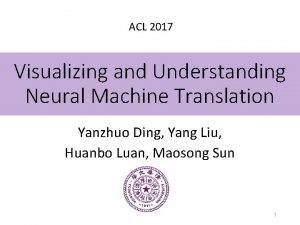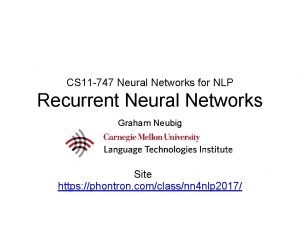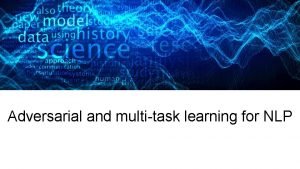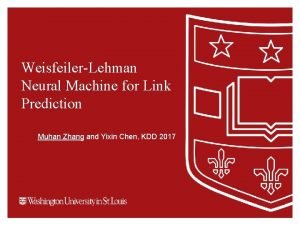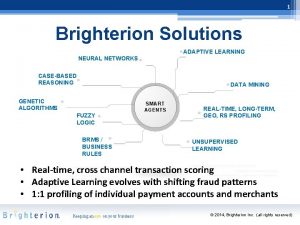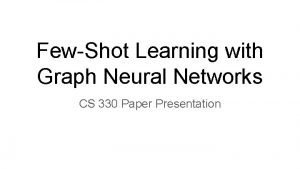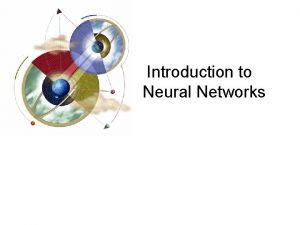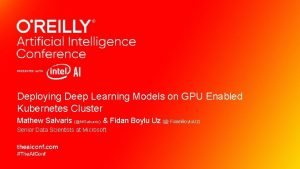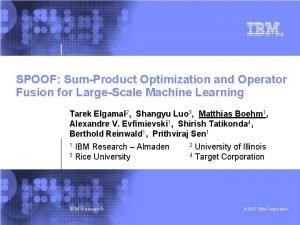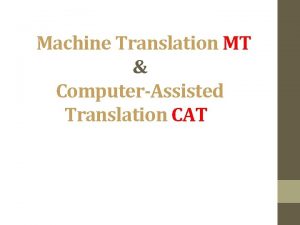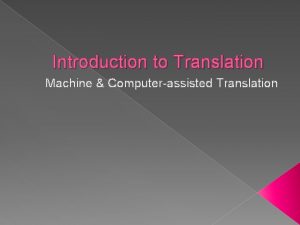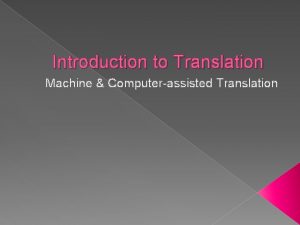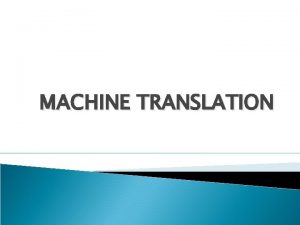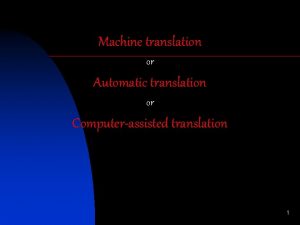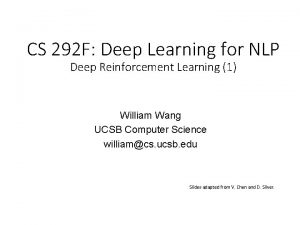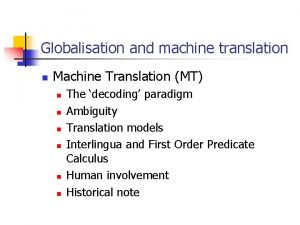NLP Deep Learning Sequencetosequence and Neural Machine Translation











![Multilingual Embeddings [Hermann and Blunsom 2013: https: //arxiv. org/abs/1312. 6173] Multilingual Embeddings [Hermann and Blunsom 2013: https: //arxiv. org/abs/1312. 6173]](https://slidetodoc.com/presentation_image_h/cc25663b2b46d194ec77bc72b0197cea/image-12.jpg)

![[Koehn 2017] [Koehn 2017]](https://slidetodoc.com/presentation_image_h/cc25663b2b46d194ec77bc72b0197cea/image-14.jpg)
![[Koehn 2017] [Koehn 2017]](https://slidetodoc.com/presentation_image_h/cc25663b2b46d194ec77bc72b0197cea/image-15.jpg)
![[Koehn 2017] [Koehn 2017]](https://slidetodoc.com/presentation_image_h/cc25663b2b46d194ec77bc72b0197cea/image-16.jpg)
![[Koehn 2017] [Koehn 2017]](https://slidetodoc.com/presentation_image_h/cc25663b2b46d194ec77bc72b0197cea/image-17.jpg)

![[Koehn 2017] [Koehn 2017]](https://slidetodoc.com/presentation_image_h/cc25663b2b46d194ec77bc72b0197cea/image-19.jpg)
![Beam Decoding [Koehn 2017] Beam Decoding [Koehn 2017]](https://slidetodoc.com/presentation_image_h/cc25663b2b46d194ec77bc72b0197cea/image-20.jpg)
![Beam Decoding [Koehn 2017] Beam Decoding [Koehn 2017]](https://slidetodoc.com/presentation_image_h/cc25663b2b46d194ec77bc72b0197cea/image-21.jpg)
![Domain Transfer [Koehn 2017] Domain Transfer [Koehn 2017]](https://slidetodoc.com/presentation_image_h/cc25663b2b46d194ec77bc72b0197cea/image-22.jpg)
![[Koehn 2017] [Koehn 2017]](https://slidetodoc.com/presentation_image_h/cc25663b2b46d194ec77bc72b0197cea/image-23.jpg)
![[Koehn 2017] [Koehn 2017]](https://slidetodoc.com/presentation_image_h/cc25663b2b46d194ec77bc72b0197cea/image-24.jpg)









- Slides: 33

NLP

Deep Learning Sequence-to-sequence and Neural Machine Translation

Machine Translation (MT) • Goal: Translate text from one language to the other – Both Language Understanding and Language Generation

Progress in Machine Translation https: //nlp. stanford. edu/projects/nmt/Luong-Cho-Manning-NMT-ACL 2016 -v 4. pdf

Statistical Machine Translation • Rise in early 90 s • Exploit Parallel Text • Word alignment Slide credit to Karl Stratos

Neural Machine Translation • Modeling the machine translation using neural networks – Encoder for language understanding in source language – Decoder for language generation in target language https: //nlp. stanford. edu/projects/nmt/Luong-Cho-Manning-NMT-ACL 2016 -v 4. pdf

Use RNNs as Encoder and Decoder • A Recurrent Neural Network, or RNN, is a network that operates on a sequence and uses its own output as input for subsequent steps. • A sequence-to-sequence network, or Encoder Decoder network, is a model consisting of two RNNs called the encoder and the decoder. • The encoder reads an input sequence and outputs vectors, and the decoder reads encoder outputs as input to produce an output sequence. Slides from Rui Zhang

Sequence to Sequence Model Sutskever, Le, and Vinyals 2014

Sequence to Sequence Model Sutskever, Le, and Vinyals 2014

Sequence to Sequence Model Sutskever, Le, and Vinyals 2014

Sequence to Sequence Model Sutskever, Le, and Vinyals 2014
![Multilingual Embeddings Hermann and Blunsom 2013 https arxiv orgabs1312 6173 Multilingual Embeddings [Hermann and Blunsom 2013: https: //arxiv. org/abs/1312. 6173]](https://slidetodoc.com/presentation_image_h/cc25663b2b46d194ec77bc72b0197cea/image-12.jpg)
Multilingual Embeddings [Hermann and Blunsom 2013: https: //arxiv. org/abs/1312. 6173]

Use RNNs as Encoder and Decoder https: //nlp. stanford. edu/pubs/luong 2016 iclr_multi. pdf
![Koehn 2017 [Koehn 2017]](https://slidetodoc.com/presentation_image_h/cc25663b2b46d194ec77bc72b0197cea/image-14.jpg)
[Koehn 2017]
![Koehn 2017 [Koehn 2017]](https://slidetodoc.com/presentation_image_h/cc25663b2b46d194ec77bc72b0197cea/image-15.jpg)
[Koehn 2017]
![Koehn 2017 [Koehn 2017]](https://slidetodoc.com/presentation_image_h/cc25663b2b46d194ec77bc72b0197cea/image-16.jpg)
[Koehn 2017]
![Koehn 2017 [Koehn 2017]](https://slidetodoc.com/presentation_image_h/cc25663b2b46d194ec77bc72b0197cea/image-17.jpg)
[Koehn 2017]

![Koehn 2017 [Koehn 2017]](https://slidetodoc.com/presentation_image_h/cc25663b2b46d194ec77bc72b0197cea/image-19.jpg)
[Koehn 2017]
![Beam Decoding Koehn 2017 Beam Decoding [Koehn 2017]](https://slidetodoc.com/presentation_image_h/cc25663b2b46d194ec77bc72b0197cea/image-20.jpg)
Beam Decoding [Koehn 2017]
![Beam Decoding Koehn 2017 Beam Decoding [Koehn 2017]](https://slidetodoc.com/presentation_image_h/cc25663b2b46d194ec77bc72b0197cea/image-21.jpg)
Beam Decoding [Koehn 2017]
![Domain Transfer Koehn 2017 Domain Transfer [Koehn 2017]](https://slidetodoc.com/presentation_image_h/cc25663b2b46d194ec77bc72b0197cea/image-22.jpg)
Domain Transfer [Koehn 2017]
![Koehn 2017 [Koehn 2017]](https://slidetodoc.com/presentation_image_h/cc25663b2b46d194ec77bc72b0197cea/image-23.jpg)
[Koehn 2017]
![Koehn 2017 [Koehn 2017]](https://slidetodoc.com/presentation_image_h/cc25663b2b46d194ec77bc72b0197cea/image-24.jpg)
[Koehn 2017]

GRU Encoder • • For every input word in the sentence, it is first used to index a word embedding matrix to get its embedding. Then the encoder produces an output vector and a hidden state from the word embedding and the previous hidden state. The hidden state is used for the next input word. The initial hidden state is initialized as a zero vector.

GRU Decoder • • • The decoder is another RNN that outputs a sequence of words. The simple decoder uses only the last output of the encoder, which is called context vector. At each step, the decoder takes an input word and the previous hidden state. At the very beginning, the input token is the start-ofsentence<SOS>token, and the hidden state is the context vector encoding the meaning of the source sentence. Then the decoder will work as illustrated below to produce an output vector and a hidden state for next step. The output vector is a probability distribution over the target language vocabulary.

Adding Attention to the Decoder • The simple decoder takes the final hidden state of the encoder and uses that to decode the target sentence. This requires to encode the entire sentence into a single fixed-size vector, which is difficult. • To solve this, we use the attention mechanism such that all the hidden states of the encoder are used to decode the target sentence.

Attention Illustration At each step of decoding, the decoder attention focuses on different parts of the input sentence. [Bahdanau, Cho, Bengio ICLR 2015]

Google Neural Translation System https: //research. googleblog. com/2016/09/a-neural-network-for-machine. html

Google Neural Translation System https: //research. googleblog. com/2016/09/a-neural-network-for-machine. html

Data Needs: SMT vs. NMT Slide from Philipp Koehn

Software/Code in Homework 5 - NMT • Data Processing – Read normalize, filter sentence pairs – prepare_data. py • Py. Torch – Build, Train, Evaluate NMT model – run_nmt. py, network. py • Matplotlib – Plot Attention produced by NMT model – Plot. py • BLEU evaluator – Calcualte BLEU scores given system outputs and gold standard sentences – Bleu. py

NLP
 Deep forest towards an alternative to deep neural networks
Deep forest towards an alternative to deep neural networks Visualizing and understanding neural machine translation
Visualizing and understanding neural machine translation Deep learning vs machine learning
Deep learning vs machine learning 11-747 neural networks for nlp
11-747 neural networks for nlp Tony wagner's seven survival skills
Tony wagner's seven survival skills Mippers
Mippers Efficient processing of deep neural networks
Efficient processing of deep neural networks Inductive and analytical learning in machine learning
Inductive and analytical learning in machine learning Inductive and analytical learning in machine learning
Inductive and analytical learning in machine learning Remarks on lazy and eager learning
Remarks on lazy and eager learning Adversarial multi-task learning for text classification
Adversarial multi-task learning for text classification Deep asleep deep asleep it lies
Deep asleep deep asleep it lies 深哉深哉耶穌的愛
深哉深哉耶穌的愛 Neural networks and learning machines 3rd edition
Neural networks and learning machines 3rd edition Neural networks and learning machines
Neural networks and learning machines Concept learning task in machine learning
Concept learning task in machine learning Analytical learning in machine learning
Analytical learning in machine learning Pac learning model in machine learning
Pac learning model in machine learning Pac learning model in machine learning
Pac learning model in machine learning Instance based learning in machine learning
Instance based learning in machine learning Inductive learning machine learning
Inductive learning machine learning First order rule learning in machine learning
First order rule learning in machine learning Communicative translation theory
Communicative translation theory Transformation of functions
Transformation of functions Weisfeiler-lehman neural machine for link prediction
Weisfeiler-lehman neural machine for link prediction Cuadro comparativo de e-learning
Cuadro comparativo de e-learning Adaptive learning neural network
Adaptive learning neural network Few shot learning with graph neural networks
Few shot learning with graph neural networks Terminator learning computer
Terminator learning computer Autoencoders, unsupervised learning, and deep architectures
Autoencoders, unsupervised learning, and deep architectures Kubernetes gpgpu
Kubernetes gpgpu Voice translation rules
Voice translation rules Noun to noun
Noun to noun Operator fusion deep learning
Operator fusion deep learning

